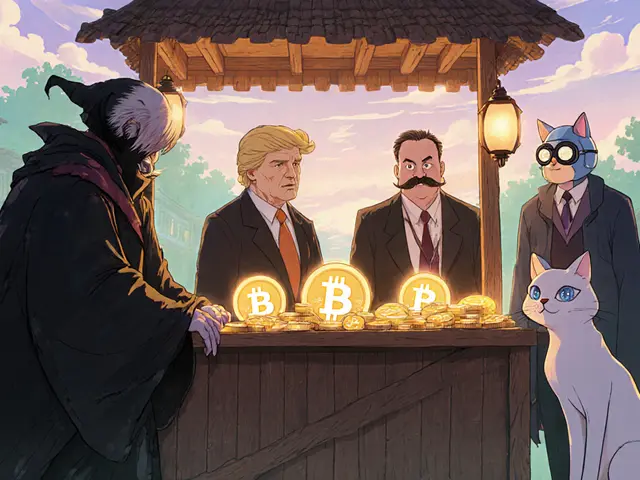Real Estate NFTs: Tokenized Property on the Blockchain
When you hear real estate NFTs, digital tokens that represent ownership or a share of physical or virtual property on a blockchain. Also known as property tokens, they let anyone buy, sell, or trade pieces of real estate just like a crypto coin. The rise of real estate NFTs is reshaping how we think about property rights. Real estate NFTs encompass tokenized property assets, which means a single building can be split into hundreds of tradable fragments. These fragments are a type of NFTs, unique, non‑fungible tokens stored on a blockchain that guarantee scarcity and provenance. Because they run on blockchain, a decentralized ledger that records every transaction permanently, ownership transfers are instant, transparent, and resistant to fraud. To enforce the rules of each token, developers rely on smart contracts, self‑executing code that automates payments, royalties, and compliance checks, making the entire process trustless and auditable.
Why Real Estate NFTs Matter Today
Tokenization opens the door to fractional ownership, so investors can purchase a 0.1% slice of a downtown office tower without needing a mortgage. This lowers the entry barrier, diversifies portfolios, and creates liquidity in a market that traditionally moves slowly. Fractional ownership also encourages broader participation from regions with strict capital controls, because the underlying blockchain can be accessed globally. For developers, smart contracts provide built‑in escrow and automated revenue sharing, which reduces legal overhead and speeds up transactions. Meanwhile, the same technology fuels virtual land sales in metaverse platforms, where developers mint parcels of digital real estate as NFTs and sell them to gamers, brands, or collectors.
Regulatory frameworks are catching up fast. Countries that have introduced clear crypto taxation rules, like Switzerland and Singapore, are also defining how tokenized property should be reported for tax purposes. In jurisdictions with strict real‑estate laws, smart contracts must be linked to official land registries to be considered legally binding. This convergence of law and code means that a real estate NFT can serve as both a financial instrument and a legally recognized title deed, provided the underlying smart contract references the correct registry entry. As compliance tools improve, we’re seeing more institutional players experiment with tokenized REITs and cross‑border property funds.
Beyond the technical side, real estate NFTs are sparking new business models. Property managers can issue maintenance‑fee NFTs that automatically deduct from owners’ wallets each month. Architects can sell design rights as NFTs, giving buyers perpetual royalties whenever the design is used. Investors can set up automated dividend streams that trigger on rental income, all handled by smart contracts without a middleman. The ecosystem is still young, but each new use case adds a layer of utility that makes the token more than just a speculative asset.
Below you’ll find deep‑dive reviews, market analysis, and step‑by‑step guides that break down these concepts. From exchange comparisons to regulatory overviews, the collection is designed to help you understand how real estate NFTs work, why they matter, and how you can start using them today.
30
How Fractional Real Estate NFTs Let You Invest in Property for Less
Learn how fractional real estate NFTs split property into digital shares, lower entry costs, boost liquidity, and what risks to watch. A step‑by‑step guide for new investors.
Latest Posts
Popular Posts
-
 Xena Exchange Crypto Exchange Review: Professional Tools vs. Regulatory Risks
Xena Exchange Crypto Exchange Review: Professional Tools vs. Regulatory Risks
-
 What is Bitgert (BRISE) crypto coin? Full breakdown of the blockchain, tokenomics, and real-world performance
What is Bitgert (BRISE) crypto coin? Full breakdown of the blockchain, tokenomics, and real-world performance
-
 What Is Collateralization in DeFi? A Clear Guide to How It Works and Why It Matters
What Is Collateralization in DeFi? A Clear Guide to How It Works and Why It Matters
-
 What is Privix New (PRIVIX) Crypto Coin? Facts, Price, and Risks in 2025
What is Privix New (PRIVIX) Crypto Coin? Facts, Price, and Risks in 2025
-
 What is LUXO (LUXO) crypto coin? The truth about the luxury authentication token
What is LUXO (LUXO) crypto coin? The truth about the luxury authentication token
Tags
- crypto exchange
- cryptocurrency
- crypto exchange review
- meme cryptocurrency
- blockchain
- cryptocurrency compliance
- Binance Smart Chain
- CoinMarketCap airdrop
- underground crypto Nepal
- crypto airdrop guide
- crypto staking
- Bitcoin mining Iran
- airdrop
- Ethereum staking
- GENIUS Act
- liquid staking
- cryptocurrency exchange security
- crypto
- crypto airdrop
- crypto regulations



